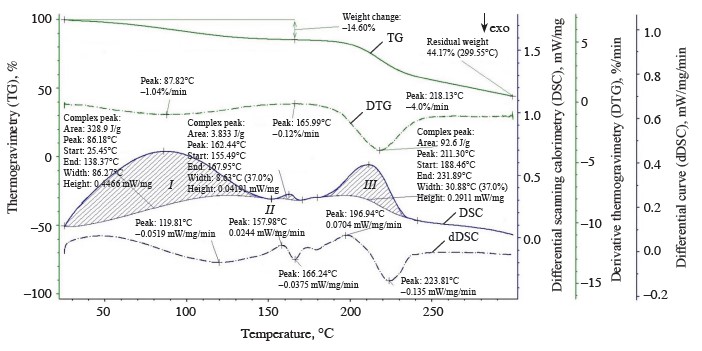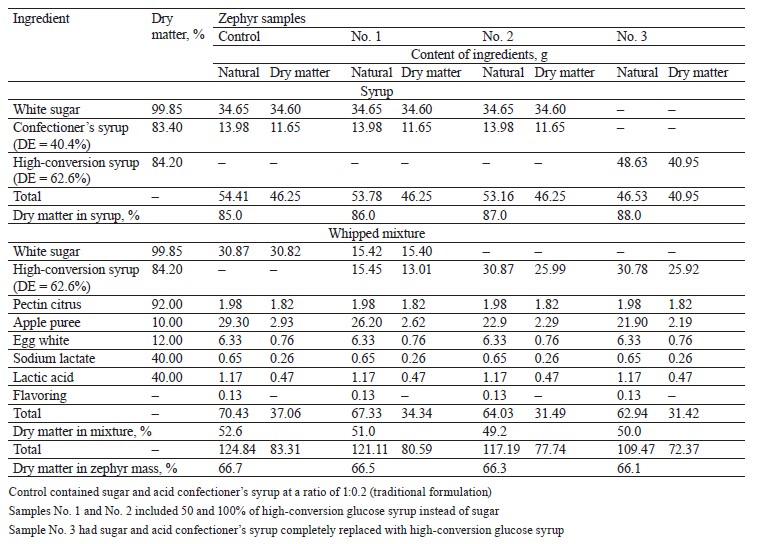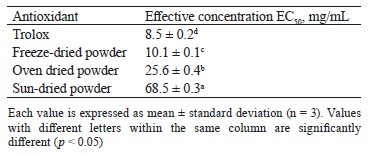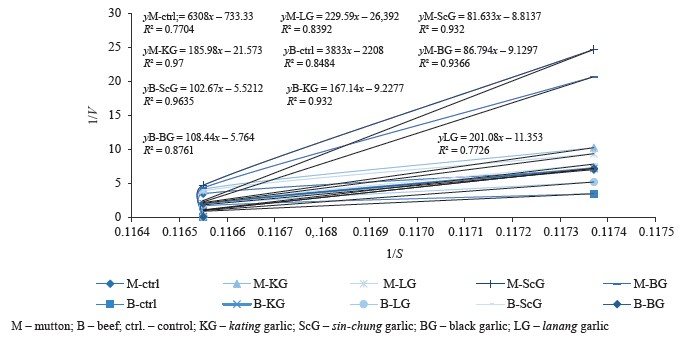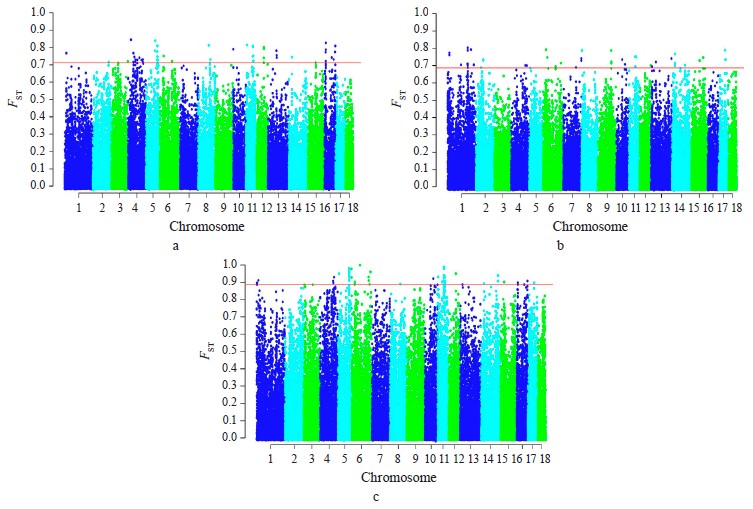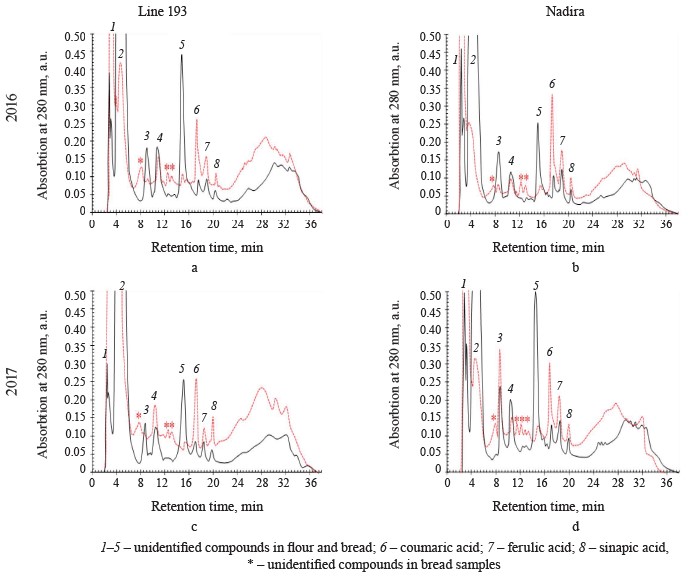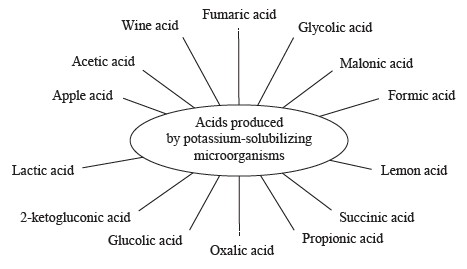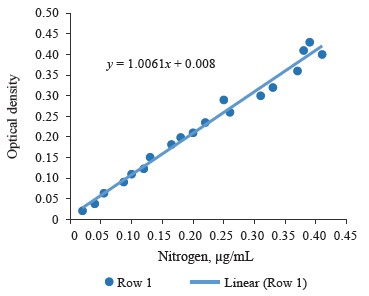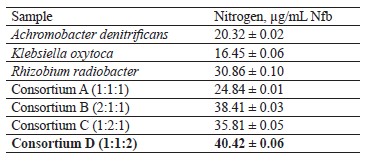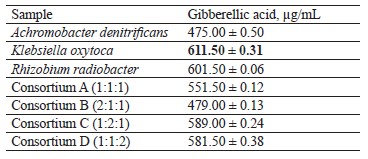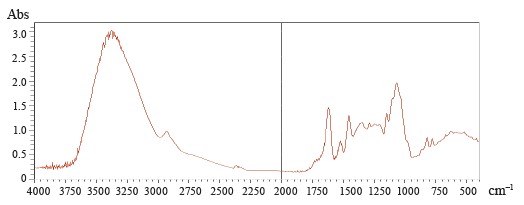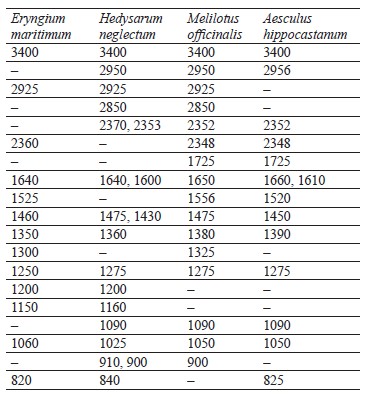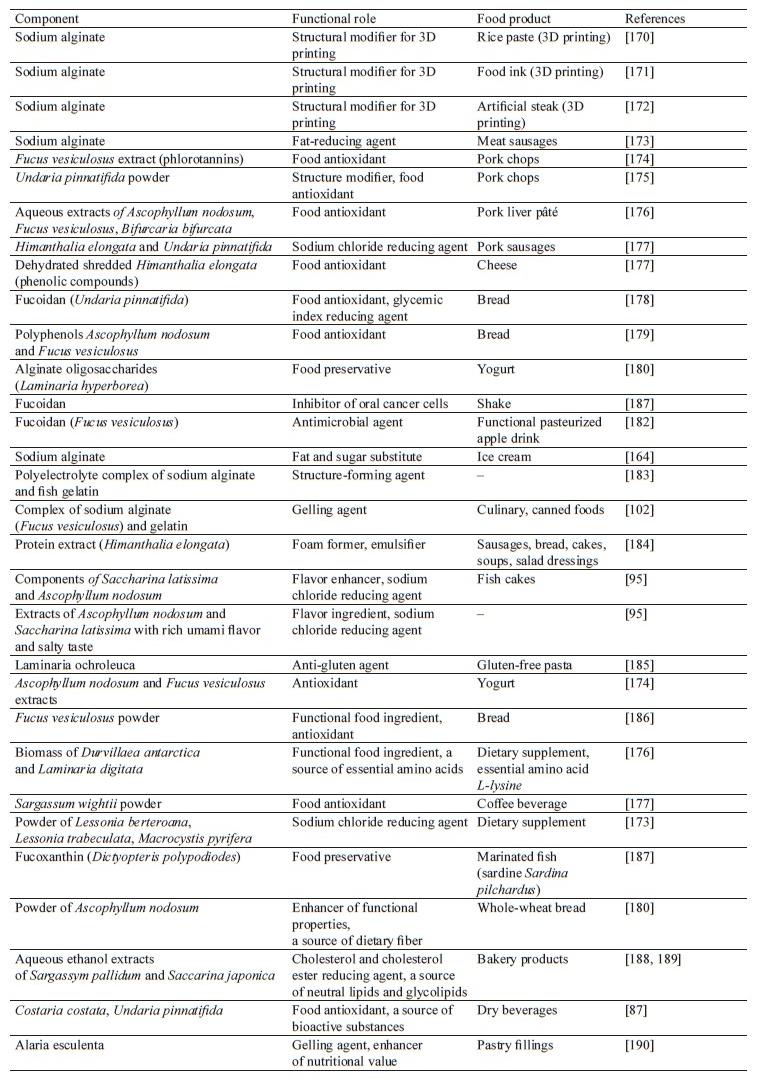Volume 12, Issue 2, 2024
Differential thermal analysis of moisture binding in zephyr with different contents of glucose syrup
9735
Abstract
Tables and figures
When formulating a product, it is just as important to measure changes in free and bound moisture as it is to analyze quality indicators. Zephyr, a Russian whipped dessert, made with sugar dries quickly during storage, gradually losing its moisture. Its crystalline sugar crust thickens and its entire mass saccharifies, resulting in higher firmness and poor appearance. In this study, we aimed to determine the effect of high-conversion glucose syrup on the amount of moisture and its binding forms in zephyr after storage.
We studied four samples of pectin-based zephyr with different carbohydrate profiles after three months of storage. Differential scanning calorimetry, thermogravimetry, and non-isothermal kinetics were applied to assess moisture contents and forms of binding in zephyr.
Thermograms with thermoanalytical curves were used to analyze the thermolysis of zephyr samples with different contents of glucose syrup in the temperature range from 20 to 300°C. We also studied the endothermic effects at various stages of thermolysis and measured free and bound moisture in the samples. Four stages of their dehydration were identified on the basis of graphical dependences between weight changes and heating temperatures.
The control zephyr sample contained more capillary and polymolecular bound moisture, while the experimental samples in which sugar and confectioner’s syrup were partially or completely replaced with high-conversion glucose syrup had more polymolecular and monomolecular bound moisture. The use of high-conversion glucose syrup instead of sugar and confectioner’s syrup reduced the amount of free moisture and therefore increased the amount of bound moisture, keeping zephyr fresh throughout its shelf life.
We studied four samples of pectin-based zephyr with different carbohydrate profiles after three months of storage. Differential scanning calorimetry, thermogravimetry, and non-isothermal kinetics were applied to assess moisture contents and forms of binding in zephyr.
Thermograms with thermoanalytical curves were used to analyze the thermolysis of zephyr samples with different contents of glucose syrup in the temperature range from 20 to 300°C. We also studied the endothermic effects at various stages of thermolysis and measured free and bound moisture in the samples. Four stages of their dehydration were identified on the basis of graphical dependences between weight changes and heating temperatures.
The control zephyr sample contained more capillary and polymolecular bound moisture, while the experimental samples in which sugar and confectioner’s syrup were partially or completely replaced with high-conversion glucose syrup had more polymolecular and monomolecular bound moisture. The use of high-conversion glucose syrup instead of sugar and confectioner’s syrup reduced the amount of free moisture and therefore increased the amount of bound moisture, keeping zephyr fresh throughout its shelf life.
5075
Abstract
Tables and figures
The wild mushroom Volvariella volvacea is widely picked and consumed in Côte d’Ivoire. However, it is highly perishable due to its high moisture content. This study aimed to determine the effects of three drying methods on the biochemical and mineral composition, as well as antioxidant properties, of V. volvacea powders.
Three V. volvacea powders were obtained by sun drying, oven drying, and freeze-drying. Each powder was analyzed for its biochemical and mineral composition according to standard analytical methods. The powder methanolic extracts were analyzed for their antioxidant components by colorimetric methods or titration, while their antioxidant capacities were determined by using DPPH (2,2-diphenyl-1-picryl-hydrazyl-hydrate) scavenging and the ferric reducing antioxidant power.
The freeze-dried powder of V. volvacea had a lower moisture content than the oven-dried and sun-dried powders. The highest protein, ash, and fiber contents were also recorded in the freeze-dried powder. In addition, freeze-drying provided the highest contents of iron, magnesium, sodium, and potassium. Regarding the antioxidant components, the freeze-dried powder showed the highest levels of total phenolic compounds, flavonoids, and vitamin C. Similarly, freeze-drying provided the best antioxidant capacities in terms of DPPH scavenging and the ferric reducing antioxidant power.
Our study showed that freeze-drying ensured a better retention of essential nutrients and antioxidant components in the mushroom V. volvacea, while sun-drying led to greater losses of these compounds.
Three V. volvacea powders were obtained by sun drying, oven drying, and freeze-drying. Each powder was analyzed for its biochemical and mineral composition according to standard analytical methods. The powder methanolic extracts were analyzed for their antioxidant components by colorimetric methods or titration, while their antioxidant capacities were determined by using DPPH (2,2-diphenyl-1-picryl-hydrazyl-hydrate) scavenging and the ferric reducing antioxidant power.
The freeze-dried powder of V. volvacea had a lower moisture content than the oven-dried and sun-dried powders. The highest protein, ash, and fiber contents were also recorded in the freeze-dried powder. In addition, freeze-drying provided the highest contents of iron, magnesium, sodium, and potassium. Regarding the antioxidant components, the freeze-dried powder showed the highest levels of total phenolic compounds, flavonoids, and vitamin C. Similarly, freeze-drying provided the best antioxidant capacities in terms of DPPH scavenging and the ferric reducing antioxidant power.
Our study showed that freeze-drying ensured a better retention of essential nutrients and antioxidant components in the mushroom V. volvacea, while sun-drying led to greater losses of these compounds.
10984
Abstract
Tables and figures
Fruit powders possess numerous benefits compared to fresh raw materials, i.e., extended shelf-life, convenient transportation and storage, a wide range of applications, etc. Nonetheless, the storage time of fruit powders depends on such factors as storage conditions, packaging, etc.
This review suggests a comprehensive analysis of articles, reviews, reports, and books indexed in Scopus, Web of Science, and eLIBRARY.RU, as well as reported at conference proceedings and other scholarly resources in 2005–2022.
Due to their high hygroscopicity, powders tend to absorb moisture from the environment and become prone to caking. Anticaking agents can prevent powders from this process. Different packaging materials also affect the compounds and properties of fruit powders. Accelerated degradation and temperature models can predict shelfp-life. This review featured the effectiveness of different anti-caking agents, as well as the impact of various packaging methods on the storage of powders. Calcium phosphate demonstrated excellent anti-caking properties, reduced hygroscopicity, and enhanced flowability. Aluminum laminated packaging proved effective in protecting powders during storage. As the storage time increased, powders demonstrated only a slight increase in moisture content. Their L* value (light to dark) and b* value (yellow to blue) decreased while the a* value (green to red) and the total color change increased. Caking increased as the flowability, pigment content, and antioxidant content went down.
The review has practical implications for developing new technologies aimed at prolonging the storage time of spray-dried fruit powders.
This review suggests a comprehensive analysis of articles, reviews, reports, and books indexed in Scopus, Web of Science, and eLIBRARY.RU, as well as reported at conference proceedings and other scholarly resources in 2005–2022.
Due to their high hygroscopicity, powders tend to absorb moisture from the environment and become prone to caking. Anticaking agents can prevent powders from this process. Different packaging materials also affect the compounds and properties of fruit powders. Accelerated degradation and temperature models can predict shelfp-life. This review featured the effectiveness of different anti-caking agents, as well as the impact of various packaging methods on the storage of powders. Calcium phosphate demonstrated excellent anti-caking properties, reduced hygroscopicity, and enhanced flowability. Aluminum laminated packaging proved effective in protecting powders during storage. As the storage time increased, powders demonstrated only a slight increase in moisture content. Their L* value (light to dark) and b* value (yellow to blue) decreased while the a* value (green to red) and the total color change increased. Caking increased as the flowability, pigment content, and antioxidant content went down.
The review has practical implications for developing new technologies aimed at prolonging the storage time of spray-dried fruit powders.
5418
Abstract
Tables and figures
Allium sativum L. protease still remains largely understudied although new varieties of garlic appear quite often, e.g., lanang garlic. This study tested the antibacterial effect of garlic and the effectiveness of various A. sativum proteases as meat tenderizers.
The research involved powder extracts of four varieties of A. sativum: kating, lanang, black garlic, and sin-chung. The degradation kinetics was defined based on the Lineweaver-Burk equation. The degradation zones were measured using sodium dodecyl sulphate poly acrylamide gel electrophoresis (SDS-PAGE). Scan electron microscopy served to test the changes in meat connective tissue.
Lanang demonstrated the largest inhibition zones against Escherichia coli (9.75 ± 0.15 mm) and Staphylococcus aureus (1.04 mm). Sin-chung protease degraded beef protein with the highest Vmax of 0.1818 μg/μL/min at 10–22 KDa (small peptide, troponin C, and troponin I), 25–40 KDa (myosin light chain, troponin T, α- and β-tropomyosin, actin), and 100–140 KDa (protein C). The same garlic variety degraded mutton meat protein at 10–17 KDa (small peptide) and 25–40 KDa (myosin light chain, troponin T, α- and β-tropomyosin, actin) with Vmax of 0.1135 μg/μL/min.
All four A. sativum proteases proved to be quite effective meat tenderizers.
The research involved powder extracts of four varieties of A. sativum: kating, lanang, black garlic, and sin-chung. The degradation kinetics was defined based on the Lineweaver-Burk equation. The degradation zones were measured using sodium dodecyl sulphate poly acrylamide gel electrophoresis (SDS-PAGE). Scan electron microscopy served to test the changes in meat connective tissue.
Lanang demonstrated the largest inhibition zones against Escherichia coli (9.75 ± 0.15 mm) and Staphylococcus aureus (1.04 mm). Sin-chung protease degraded beef protein with the highest Vmax of 0.1818 μg/μL/min at 10–22 KDa (small peptide, troponin C, and troponin I), 25–40 KDa (myosin light chain, troponin T, α- and β-tropomyosin, actin), and 100–140 KDa (protein C). The same garlic variety degraded mutton meat protein at 10–17 KDa (small peptide) and 25–40 KDa (myosin light chain, troponin T, α- and β-tropomyosin, actin) with Vmax of 0.1135 μg/μL/min.
All four A. sativum proteases proved to be quite effective meat tenderizers.
4733
Abstract
Tables and figures
Consumption of cassava meal affected by crude oil has significant effects on lipid and protein metabolism. The hepatoprotective action of spices is mostly attributed to the suppression of lipid oxidation and protein breakdown. This study examined the protein restoration and anti-lipidemic potential of Monodora myristica (Gaertn.) in rats fed with cassava contaminated with crude oil.
The research involved 36 albino rats separated into six groups (n = 6). Group 1 (control) consumed cassava without crude oil. Group 2 received cassava with crude oil. Groups 3, 4, and 5 fed on cassava with crude oil and various extracts of M. myristica, i.e., aqueous, ethanol, and diethyl ether, respectively. Group 6 received non-ionic synthetic surfactant Tween 80. The experiment relied on standard methods.
Blood serum and liver obtained from the rats of Group 2 showed a significant (p < 0.05) increase in total cholesterol, low density lipoprotein cholesterol, triacylglycerol, and malondialdehyde, as well as a decrease in total protein, albumin, and high-density lipoprotein cholesterol. The groups that received M. myristica extracts showed a significant increase (p < 0.05) in total protein, albumin, and high-density lipoprotein cholesterol. They also had lower total cholesterol, low density lipoprotein cholesterol, triacylglycerol, and malondialdehyde as compared to Group 2, which dieted on cassava contaminated with crude oil without additives.
In this research, crude oil-contaminated cassava affected proteins and lipids in rats. Diethyl ether extract of M. myristica demonstrated the best anti-lipidemic and protein restoration.
The research involved 36 albino rats separated into six groups (n = 6). Group 1 (control) consumed cassava without crude oil. Group 2 received cassava with crude oil. Groups 3, 4, and 5 fed on cassava with crude oil and various extracts of M. myristica, i.e., aqueous, ethanol, and diethyl ether, respectively. Group 6 received non-ionic synthetic surfactant Tween 80. The experiment relied on standard methods.
Blood serum and liver obtained from the rats of Group 2 showed a significant (p < 0.05) increase in total cholesterol, low density lipoprotein cholesterol, triacylglycerol, and malondialdehyde, as well as a decrease in total protein, albumin, and high-density lipoprotein cholesterol. The groups that received M. myristica extracts showed a significant increase (p < 0.05) in total protein, albumin, and high-density lipoprotein cholesterol. They also had lower total cholesterol, low density lipoprotein cholesterol, triacylglycerol, and malondialdehyde as compared to Group 2, which dieted on cassava contaminated with crude oil without additives.
In this research, crude oil-contaminated cassava affected proteins and lipids in rats. Diethyl ether extract of M. myristica demonstrated the best anti-lipidemic and protein restoration.
5013
Abstract
Tables and figures
Persimmon juice has good nutritional composition and high antioxidant properties, however it requires more packing space because of large volume and has limited shelf-life. The research objective was to produce persimmon purée powder with prolonged shelf-life by using various concentrations of drying agents (maltodextrin and Arabic gum).
The control sample was persimmon purée powder without drying agents. Experimental samples included powders with maltodextrin (40, 45, and 50%), Arabic gum (25, 30, and 35%), and the mix of maltodextrin (40%) and Arabic gum (10%). All the experimental samples contained 1% of tri-calcium phosphate as an anti-caking agent. Tests were carried out according to the standard techniques.
The samples with 45 and 50% of maltodextrin had lower moisture, ash, redness (a*), and hygroscopicity values. These powders demonstrated good yield, solubility, density, and color indices (L*, b*, C, H). The persimmon purée powders with 30 and 35% of Arabic gum showed an increase in ash content and total acidity. The samples with 30% of Arabic gum obtained the highest sensory evaluation scores.
The optimal results belonged to the samples of lyophilized persimmon purée powder with 45% of maltodextrin, which will have a longer shelf-life due to its low moisture content.
The control sample was persimmon purée powder without drying agents. Experimental samples included powders with maltodextrin (40, 45, and 50%), Arabic gum (25, 30, and 35%), and the mix of maltodextrin (40%) and Arabic gum (10%). All the experimental samples contained 1% of tri-calcium phosphate as an anti-caking agent. Tests were carried out according to the standard techniques.
The samples with 45 and 50% of maltodextrin had lower moisture, ash, redness (a*), and hygroscopicity values. These powders demonstrated good yield, solubility, density, and color indices (L*, b*, C, H). The persimmon purée powders with 30 and 35% of Arabic gum showed an increase in ash content and total acidity. The samples with 30% of Arabic gum obtained the highest sensory evaluation scores.
The optimal results belonged to the samples of lyophilized persimmon purée powder with 45% of maltodextrin, which will have a longer shelf-life due to its low moisture content.
6364
Abstract
Tables and figures
Every year, metabolic syndrome and cardiorenal diseases cause many deaths worldwide. African bitter leaf (Vernonia amygdalina L.) is known for its numerous therapeutic effects. Potentially, it can lower plasma lipid and glucose levels, which, in turn, may improve the condition of patients with the abovementioned diseases. This research featured the antihyperlipidemic and antihyperglycemic effects of methanol extract of V. amygdalina in an animal model of metabolic syndrome.
Twenty albino rats were divided into four groups. Groups A to C were orally administered with ghee (3 mL/kg) + high-cholesterol diet (500 mg/kg) + high-sugar diet (10 mL/kg) to induce metabolic syndrome. Group A served as negative control and received no treatment with bitter leaf methanol extract. Groups B and C received 200 and 400 mg/kg of V. amygdalina methanol extract, respectively. Group D received no administration. The cardiorenal injuries and alterations in blood lipids and sugar levels wereassessed via various biochemical analyses.
The combination of ghee + high-cholesterol diet + high-sugar diet triggered a significant elevation of creatine kinase myocardial band, lactate dehydrogenase, aspartate aminotransferase, triglycerides, total cholesterol, low density lipoprotein-cholesterol, glucose, urea, creatinine, and potassium levels. The histopathological results agreed with the biochemical findings. However, the treatment with 200 and 400 mg/kg of V. amygdalina methanol extract was able to inhibit the adverse alterations causing a dosedependent significant antihyperlipidemic and antihyperglycemic effect (p < 0.05).
Bitter leaf (V. amygdalina) demonstrated cardiorenal protective effects and may be used to manage metabolic syndrome.
Twenty albino rats were divided into four groups. Groups A to C were orally administered with ghee (3 mL/kg) + high-cholesterol diet (500 mg/kg) + high-sugar diet (10 mL/kg) to induce metabolic syndrome. Group A served as negative control and received no treatment with bitter leaf methanol extract. Groups B and C received 200 and 400 mg/kg of V. amygdalina methanol extract, respectively. Group D received no administration. The cardiorenal injuries and alterations in blood lipids and sugar levels wereassessed via various biochemical analyses.
The combination of ghee + high-cholesterol diet + high-sugar diet triggered a significant elevation of creatine kinase myocardial band, lactate dehydrogenase, aspartate aminotransferase, triglycerides, total cholesterol, low density lipoprotein-cholesterol, glucose, urea, creatinine, and potassium levels. The histopathological results agreed with the biochemical findings. However, the treatment with 200 and 400 mg/kg of V. amygdalina methanol extract was able to inhibit the adverse alterations causing a dosedependent significant antihyperlipidemic and antihyperglycemic effect (p < 0.05).
Bitter leaf (V. amygdalina) demonstrated cardiorenal protective effects and may be used to manage metabolic syndrome.
5075
Abstract
Tables and figures
Macro- and microelements are vital components of the nutrient profile of apples and apple juice. Although the mineral composition of apple juices has been well studied, there is a lack of research into the elemental profile of ciders. We aimed to determine the concentrations of macro- and microelements in various samples of ciders.
We studied 25 experimental ciders from apple juice of direct extraction (fresh must) and 4 commercial ciders purchased from a retailer in Krasnodar. Mass concentrations of metal cations were determined by high-performance capillary electrophoresis, atomic absorption spectrometry with electrothermal atomization, and atomic emission spectrometry with inductively coupled plasma.
The concentrations of macroelements in the ciders from fresh must depending on the variety varied significantly in the following ranges (mg/L): 696–1920 for potassium; 6.7–26.8 for sodium; 4.3–35.5 for calcium; and 10.2–36.8 for magnesium. The commercial ciders had significantly lower concentrations of macroelements. The content of iron ranged from 0.86 to 2.26 mg/L. Among microelements, copper cations were detected in the range from 31.0 to 375 μg/L. The concentrations of toxic elements did not exceed the maximum permissible values in any of the samples, including the commercial ones. Finally, ranges of variation were established in the concentrations of macro- and microelements depending on the varietal characteristics of apples.
The pomological varieties of apples used in the study were grown under the same agrotechnical conditions. Therefore, the differences revealed in the elemental profile of the ciders were assumingly due to the genetic characteristics of the respective variety.
We studied 25 experimental ciders from apple juice of direct extraction (fresh must) and 4 commercial ciders purchased from a retailer in Krasnodar. Mass concentrations of metal cations were determined by high-performance capillary electrophoresis, atomic absorption spectrometry with electrothermal atomization, and atomic emission spectrometry with inductively coupled plasma.
The concentrations of macroelements in the ciders from fresh must depending on the variety varied significantly in the following ranges (mg/L): 696–1920 for potassium; 6.7–26.8 for sodium; 4.3–35.5 for calcium; and 10.2–36.8 for magnesium. The commercial ciders had significantly lower concentrations of macroelements. The content of iron ranged from 0.86 to 2.26 mg/L. Among microelements, copper cations were detected in the range from 31.0 to 375 μg/L. The concentrations of toxic elements did not exceed the maximum permissible values in any of the samples, including the commercial ones. Finally, ranges of variation were established in the concentrations of macro- and microelements depending on the varietal characteristics of apples.
The pomological varieties of apples used in the study were grown under the same agrotechnical conditions. Therefore, the differences revealed in the elemental profile of the ciders were assumingly due to the genetic characteristics of the respective variety.
5705
Abstract
Tables and figures
Livni is one of the Russian local pig breeds. We previously reported that this breed was more distinct from Duroc breed than from Landrace and the Large White breeds, which participated in the Livni breed creation. The aim of the study was to determine the SNP-based genetic signatures in fat-type Livni breed shared with commercial Landrace and the Large White breeds, and ones that are affected by putative selection.
The genome-wide SNP genotyping was carried out using the Porcine GGP HD BeadChip, which contains ~ 80 000 SNPs.
Obtained breed relationship and admixture results indicated the insignificant participation of the Landrace and the Large White breeds in the formation of the modern allelofund of Livni pigs. 238 candidate genes were found in the genomic regions with selection signatures, 182 genes with described functions were identified. In the Livni and Landrace breeds, 35 common genes were detected which formed one cluster with enrichment coefficient = 4.94 and predominant HOXD genes. In the Livni and Large White breeds, the largest amounts of common genes were detected (62 in average), which formed two clusters. Cluster 1, with enrichment coefficient = 2.11, was characterized with genes involved in glucose metabolism. Cluster 2, with enrichment coefficient = 1.60, demonstrated helicase genes. Annotated clusters were not determined for the Livni breed. However, 50 candidate genes were specific to Livni pigs and associated with various growth, carcass and reproductive traits, essential for thermoregulation.
Results revealed common SNP-based genetic signatures and breeding effects in indigenous Livni compared with Landrace and Large White breeds.
The genome-wide SNP genotyping was carried out using the Porcine GGP HD BeadChip, which contains ~ 80 000 SNPs.
Obtained breed relationship and admixture results indicated the insignificant participation of the Landrace and the Large White breeds in the formation of the modern allelofund of Livni pigs. 238 candidate genes were found in the genomic regions with selection signatures, 182 genes with described functions were identified. In the Livni and Landrace breeds, 35 common genes were detected which formed one cluster with enrichment coefficient = 4.94 and predominant HOXD genes. In the Livni and Large White breeds, the largest amounts of common genes were detected (62 in average), which formed two clusters. Cluster 1, with enrichment coefficient = 2.11, was characterized with genes involved in glucose metabolism. Cluster 2, with enrichment coefficient = 1.60, demonstrated helicase genes. Annotated clusters were not determined for the Livni breed. However, 50 candidate genes were specific to Livni pigs and associated with various growth, carcass and reproductive traits, essential for thermoregulation.
Results revealed common SNP-based genetic signatures and breeding effects in indigenous Livni compared with Landrace and Large White breeds.
6017
Abstract
Tables and figures
This study featured broad/fava bean pods as by-products of food production. It assessed the chemical composition of green bean pods (Vicia faba L.) and their methanolic extract.
The extract was tested in vitro for antioxidant, anti-inflammatory, antimicrobial, and anticancer activities against prostate cancer (Pc3) and liver cancer (HepG2) cells. Broad bean pods proved to be rich in carbohydrates, fiber, protein, potassium, calcium, and magnesium. The extract contained 286 mg GAE/g total phenols and 105 mg QE/g total flavonoids. The antioxidant activity of the methanolic extract was measured by 1,1-diphenyl-2-picryl hydrazyl (DPPH) assay. The highest DPPH scavenging activity belonged to the extract concentrations of 1000 μg/mL (80.5%) and 500 μg/mL (73.7%), whereas the IC50 value was 87.35 μg/mL. The methanolic extract possessed the anti-inflammatory effect as it significantly reduced the hemolysis of red blood cells. The maximal inhibition percentage reached 66.7% at 1000 μg/mL. Regarding the antimicrobial activity, the broad bean pod methanolic extract inhibited Bacillus subtilis, Staphylococcus aureus, Escherichia coli, and Pseudomonas aeruginosa, as well as Candida albicans. The extract reduced the cell viability of human hepatocarcinoma (HepG2) and prostate cancer (PC3) cells in a concentration-dependent manner. It also caused significant changes in cell shape, compared to the control.
Therefore, broad beans can be recommended for human consumption together with pods, fresh or cooked, as a potential source of bioactive substances in functional food production.
The extract was tested in vitro for antioxidant, anti-inflammatory, antimicrobial, and anticancer activities against prostate cancer (Pc3) and liver cancer (HepG2) cells. Broad bean pods proved to be rich in carbohydrates, fiber, protein, potassium, calcium, and magnesium. The extract contained 286 mg GAE/g total phenols and 105 mg QE/g total flavonoids. The antioxidant activity of the methanolic extract was measured by 1,1-diphenyl-2-picryl hydrazyl (DPPH) assay. The highest DPPH scavenging activity belonged to the extract concentrations of 1000 μg/mL (80.5%) and 500 μg/mL (73.7%), whereas the IC50 value was 87.35 μg/mL. The methanolic extract possessed the anti-inflammatory effect as it significantly reduced the hemolysis of red blood cells. The maximal inhibition percentage reached 66.7% at 1000 μg/mL. Regarding the antimicrobial activity, the broad bean pod methanolic extract inhibited Bacillus subtilis, Staphylococcus aureus, Escherichia coli, and Pseudomonas aeruginosa, as well as Candida albicans. The extract reduced the cell viability of human hepatocarcinoma (HepG2) and prostate cancer (PC3) cells in a concentration-dependent manner. It also caused significant changes in cell shape, compared to the control.
Therefore, broad beans can be recommended for human consumption together with pods, fresh or cooked, as a potential source of bioactive substances in functional food production.
A preprint of the manuscript for this article was published on the preprint platform Research Square. See a preprint at https://doi.org/10.21203/rs.3.rs-2591126/v1
8973
Abstract
Tables and figures
The consumption of fat raises the risk of coronary heart disease and a number of chronic diseases such as obesity. However, removing fat or reducing its level in the final product may give it undesirable properties since fat plays an important role in the quality of food, mainly its texture and flavor. Therefore, natural or artificial fat replacers are utilized in food formulations instead of natural fat. Fat mimics are based on carbohydrates, proteins, and/or lipids, with energy values of 0–38 kJ/g (0–9 kcal/g).
They mimic physical properties and sensory attributes of fat but have less energy and calories. Fat substitutes have physical and functional characteristics of conventional fat molecules which are directly replaced with synthetic molecules that provide no calories or structured lipid molecules. Dairy products represent a principal part of consumer diet all over the world.
Therefore, this review aimed to expound how fat replacers can be used to overcome the defects of fat absence or reduction in dairy products. It was reviewed different types and sources of fat replacers, both micro- and nanoparticulated, and highlighted their application in cheese, ice cream, frozen yogurt, fermented milk, and fatty dairy products. Some of the currently applied micro-particulated proteins include Simplesse® (whey protein), APV LeanCreme™, and Dairy-Lo® (micro-particulate protein + micro-particulate cellulose).
While whey protein has a great role in the dairy sector today, there is a need for further research in this field.
They mimic physical properties and sensory attributes of fat but have less energy and calories. Fat substitutes have physical and functional characteristics of conventional fat molecules which are directly replaced with synthetic molecules that provide no calories or structured lipid molecules. Dairy products represent a principal part of consumer diet all over the world.
Therefore, this review aimed to expound how fat replacers can be used to overcome the defects of fat absence or reduction in dairy products. It was reviewed different types and sources of fat replacers, both micro- and nanoparticulated, and highlighted their application in cheese, ice cream, frozen yogurt, fermented milk, and fatty dairy products. Some of the currently applied micro-particulated proteins include Simplesse® (whey protein), APV LeanCreme™, and Dairy-Lo® (micro-particulate protein + micro-particulate cellulose).
While whey protein has a great role in the dairy sector today, there is a need for further research in this field.
4908
Abstract
Tables and figures
Whole-wheat flour of purple wheat varieties contains anthocyanins and other phenolic compounds with high antioxidant activity, which makes it a potential raw material for functional foods. The content and composition of phenolic compounds in whole-wheat flour depends on the genotype and weather conditions; in the bread, however, they also depend on the bread-making technology. This article offers a comparative analysis of phenolic compounds in purple whole-wheat flour and bread baked from this flour.
The study featured purple soft spring wheat (Triticum aestivum L.) of two varieties, Nadira and Line 193, which were harvested in 2016 and 2017, and corresponding bread samples. The antioxidant activity and phenolic content were measured spectrophotometrically while the qualitative analysis relied on the method of high-performance liquid chromatography (HPLC).
In the hot and dry year of 2016, the content of bound phenolic acids reached 2.0–2.4 mg/g dry weight in the flour of both genotypes. In the cool and humid year of 2017, the content of anthocyanins in the Nadira flour increased by 2.7 times and amounted to 0.65 mg/g dry weight. However, the corresponding bread sample had a much lower phenolic content: soluble phenolics were halved, anthocyanins dropped by 3–4 times, and bound phenolic acids went down by 7–17 times. The content of bound phenolic acids in the flour correlated positively with the content of free phenolic acids in the bread. The HPLC analysis revealed an increase in the content of free hydroxycinnamic acids in the bread: p-coumaric acid was the most abundant and amounted to 0.14–0.22 mg/g dry weight.
Conventional State Standard 27669-88 for bread making resulted in a total decrease in anthocyanins, bound phenolic acids, and most free phenolics. Therefore, this technology cannot be applied to functional bread. The results can help develop a breadmaking technology for purple wheat varieties.
The study featured purple soft spring wheat (Triticum aestivum L.) of two varieties, Nadira and Line 193, which were harvested in 2016 and 2017, and corresponding bread samples. The antioxidant activity and phenolic content were measured spectrophotometrically while the qualitative analysis relied on the method of high-performance liquid chromatography (HPLC).
In the hot and dry year of 2016, the content of bound phenolic acids reached 2.0–2.4 mg/g dry weight in the flour of both genotypes. In the cool and humid year of 2017, the content of anthocyanins in the Nadira flour increased by 2.7 times and amounted to 0.65 mg/g dry weight. However, the corresponding bread sample had a much lower phenolic content: soluble phenolics were halved, anthocyanins dropped by 3–4 times, and bound phenolic acids went down by 7–17 times. The content of bound phenolic acids in the flour correlated positively with the content of free phenolic acids in the bread. The HPLC analysis revealed an increase in the content of free hydroxycinnamic acids in the bread: p-coumaric acid was the most abundant and amounted to 0.14–0.22 mg/g dry weight.
Conventional State Standard 27669-88 for bread making resulted in a total decrease in anthocyanins, bound phenolic acids, and most free phenolics. Therefore, this technology cannot be applied to functional bread. The results can help develop a breadmaking technology for purple wheat varieties.
5639
Abstract
Tables and figures
Wheat (Triticum L.) is a strategically important agricultural crop because its quality and yield provide food security for the population. Biological fertilizers improve the growth and development of agricultural crops. Unlike chemical ones, they have no toxic effect on people and the environment. This research assessed the positive effect of extremophilic microorganisms isolated from coal dump soils of the Kemerovo Region (Russia) on the growth and development of wheat.
The study featured bacterial isolates of Achromobacter denitrificans, Klebsiella oxytoca, and Rhizobium radiobacter, as well as their consortia in four different ratios: 1:1:1 (Consortium A), 2:1:1 (Consortium B), 1:2:1 (Consortium C), 1:1:2 (Consortium D), respectively. The beneficial effect was assessed by determining such factors as nitrogen fixation, solubilization of phosphates, potassium, and zinc, and production of gibberellic acid, siderophores, and hydrogen cyanide. The wheat samples were checked for germination, root length, and stem length.
R. radiobacter demonstrated the best nitrogen fixation properties. Consortium D, with two shares of R. radiobacter, yielded the best results for zinc solubilization. R. radiobacter proved to be the most efficient potassium solubilizer while the isolate of A. denitrificans was the best phosphate solubilizer. The largest amount of gibberellic acid belonged to K. oxytoca. Consortium C, which included two shares of this isolate, appeared to be the most effective siderophore producer. All samples but A. denitrificans were able to produce hydrogen cyanide. The best seed germination rate (84%) belonged to Consortium C, which contained a double share of K. oxytoca. Consortia C and B (two shares of A. denitrificans) had the greatest positive effect on the root length.
Treatment with Consortium B resulted in the longest average stem length. Extremophilic microorganisms isolated from coal dump soils of the Kemerovo Region (Russia) had a good potential as biofertilizers that could improve wheat quality and local food security.
The study featured bacterial isolates of Achromobacter denitrificans, Klebsiella oxytoca, and Rhizobium radiobacter, as well as their consortia in four different ratios: 1:1:1 (Consortium A), 2:1:1 (Consortium B), 1:2:1 (Consortium C), 1:1:2 (Consortium D), respectively. The beneficial effect was assessed by determining such factors as nitrogen fixation, solubilization of phosphates, potassium, and zinc, and production of gibberellic acid, siderophores, and hydrogen cyanide. The wheat samples were checked for germination, root length, and stem length.
R. radiobacter demonstrated the best nitrogen fixation properties. Consortium D, with two shares of R. radiobacter, yielded the best results for zinc solubilization. R. radiobacter proved to be the most efficient potassium solubilizer while the isolate of A. denitrificans was the best phosphate solubilizer. The largest amount of gibberellic acid belonged to K. oxytoca. Consortium C, which included two shares of this isolate, appeared to be the most effective siderophore producer. All samples but A. denitrificans were able to produce hydrogen cyanide. The best seed germination rate (84%) belonged to Consortium C, which contained a double share of K. oxytoca. Consortia C and B (two shares of A. denitrificans) had the greatest positive effect on the root length.
Treatment with Consortium B resulted in the longest average stem length. Extremophilic microorganisms isolated from coal dump soils of the Kemerovo Region (Russia) had a good potential as biofertilizers that could improve wheat quality and local food security.
4942
Abstract
Tables and figures
The seasonal variability in proximate composition and essential elements demonstrates that the habitat and feeding habits of fish species play a vital role in energy transfer.
We aimed to ascertain seasonal variability in the biochemical composition (protein, lipids, carbohydrates, ash, and moisture) and the amounts of Na, K, Ca, Mg, Mn, and Zn in the species Nemipterus japonicus, Epinephelus erythrurus, Nematalosa nasus, and Ilisha striatula inhabiting pelagic and demersal zones. We compared the nutritional profile of these fish species and their seasonal importance. The essential elements were detected by flame atomic absorption spectrometry and found in the following order: K > Na > Ca > Mg > Mn > Zn. To determine the proximate composition, we employed a number of methods: the Lowry method for protein analysis, the acid hydrolysis method for fat/lipid analysis, a formula for carbohydrates and moisture, and the incineration method for ash content.
The spring inter-monsoon season showed the highest values for the essential elements in both pelagic and demersal species. However, the pelagic species had the highest biochemical composition levels during the southwest monsoon. The autumn intermonsoon had the lowest bio-profile for the fishes of both regimes.
The summer season, which is not thought to be good for fish consumption, showed the highest biochemical composition levels in the pelagic fish. The nutritional profile of fish flesh can be affected by feeding habits, seasonal variation, and habitat.
We aimed to ascertain seasonal variability in the biochemical composition (protein, lipids, carbohydrates, ash, and moisture) and the amounts of Na, K, Ca, Mg, Mn, and Zn in the species Nemipterus japonicus, Epinephelus erythrurus, Nematalosa nasus, and Ilisha striatula inhabiting pelagic and demersal zones. We compared the nutritional profile of these fish species and their seasonal importance. The essential elements were detected by flame atomic absorption spectrometry and found in the following order: K > Na > Ca > Mg > Mn > Zn. To determine the proximate composition, we employed a number of methods: the Lowry method for protein analysis, the acid hydrolysis method for fat/lipid analysis, a formula for carbohydrates and moisture, and the incineration method for ash content.
The spring inter-monsoon season showed the highest values for the essential elements in both pelagic and demersal species. However, the pelagic species had the highest biochemical composition levels during the southwest monsoon. The autumn intermonsoon had the lowest bio-profile for the fishes of both regimes.
The summer season, which is not thought to be good for fish consumption, showed the highest biochemical composition levels in the pelagic fish. The nutritional profile of fish flesh can be affected by feeding habits, seasonal variation, and habitat.
7227
Abstract
Tables and figures
Medicinal plants contain various biologically active substances. This study aimed to investigate properties of plant extracts and component composition of plant raw materials from the continental part Kaliningrad region (Guards district). For this, we used column chromatography and IR spectroscopy.
The objects of the study were samples of plant extracts of Eryngium maritimum, Hedysarum neglectum, Melilotus officinalis, and Aesculus hippocastanum. To produce medicinal plant extracts, we prepared methanol extraction by the Soxhlet method for 8 h (15 cycles). The antioxidant activity of the studied samples was determined by their ability to reduce the radical 2,2-diphenyl-1-picrylhydrazyl. The disk-diffusion method was used to evaluate the antimicrobial activity of the plant extracts against such test strains as Bacillus subtilis, Escherichia coli, Pseudomonas aeruginosa, and Candida albicans.
In the extracts, 3,4-dihydroxybenzoic acid, astragalin, luteolin-7-glucoside, rosmarinic acid, and chlorogenic acid were identified. However, more research is needed to determine which of the individual phenolic compounds in E. maritimum, H. neglectum, M. officinalis, and A. hippocastanum are involved in exhibiting antioxidant activity. It was found that the plant extract of H. neglectum had activity against the bacterium B. subtilis and the mold fungus C. albicans, while the plant extract of E. maritimum was detrimental to the growth and development of both Gram-positive and Gram-negative bacteria.
Infrared spectroscopy can help in further studies to determine properties of medicinal plants to ensure the safety and efficacy of plant-based products.
The objects of the study were samples of plant extracts of Eryngium maritimum, Hedysarum neglectum, Melilotus officinalis, and Aesculus hippocastanum. To produce medicinal plant extracts, we prepared methanol extraction by the Soxhlet method for 8 h (15 cycles). The antioxidant activity of the studied samples was determined by their ability to reduce the radical 2,2-diphenyl-1-picrylhydrazyl. The disk-diffusion method was used to evaluate the antimicrobial activity of the plant extracts against such test strains as Bacillus subtilis, Escherichia coli, Pseudomonas aeruginosa, and Candida albicans.
In the extracts, 3,4-dihydroxybenzoic acid, astragalin, luteolin-7-glucoside, rosmarinic acid, and chlorogenic acid were identified. However, more research is needed to determine which of the individual phenolic compounds in E. maritimum, H. neglectum, M. officinalis, and A. hippocastanum are involved in exhibiting antioxidant activity. It was found that the plant extract of H. neglectum had activity against the bacterium B. subtilis and the mold fungus C. albicans, while the plant extract of E. maritimum was detrimental to the growth and development of both Gram-positive and Gram-negative bacteria.
Infrared spectroscopy can help in further studies to determine properties of medicinal plants to ensure the safety and efficacy of plant-based products.
4400
Abstract
Tables and figures
Khainak milk is a traditional source of nutrition for people living in the highlands of Kyrgyzstan. It is consumed both in its natural form and in the form of butter, cheese, and cottage cheese. We aimed to determine the composition of fatty acids in khainak milk, as well as its seasonal changes, since such data is lacking in literature.
Fatty acids were determined by gas chromatography qualitatively and quantitatively in the milk from five lactating khainaks farm-bred in the Issyk-Kul region. The milk samples were collected and analyzed in the spring, summer, autumn, and winter seasons over three years (2019, 2020, and 2021).
Kyrgyz khainak milk fat was mostly represented by saturated fatty acids, with a maximum content of 73.10 ± 2.19 g/100 g in winter. C14:0, C16:0, and C18:0 dominated in their composition, exceeding 5 g/100 g, with C16:0 (palmitic acid) reaching almost 35 g/100 g in winter. The flora of mountain pastures favorably contributed to monounsaturated fatty acids in khainak milk, especially oleic acid, whose content reached 26.85 ± 0.81 g/100 g in spring and then gradually declined to 18.90 ± 0.56 g/100 g, following changes in vegetation. Polyunsaturated fatty acids were found in small quantities varying from 3.25 ± 0.09 g/100 g in winter to 4.28 ± 0.12 g/100 g in summer.
The seasonal changes in the fatty acid profile of Kyrgyz khainak milk are most likely due to differences in the animals’ diet. Our data can be used to optimize the process parameters for the production of full-fat products from khainak milk (cheese, butter, sour cream, etc.).
Fatty acids were determined by gas chromatography qualitatively and quantitatively in the milk from five lactating khainaks farm-bred in the Issyk-Kul region. The milk samples were collected and analyzed in the spring, summer, autumn, and winter seasons over three years (2019, 2020, and 2021).
Kyrgyz khainak milk fat was mostly represented by saturated fatty acids, with a maximum content of 73.10 ± 2.19 g/100 g in winter. C14:0, C16:0, and C18:0 dominated in their composition, exceeding 5 g/100 g, with C16:0 (palmitic acid) reaching almost 35 g/100 g in winter. The flora of mountain pastures favorably contributed to monounsaturated fatty acids in khainak milk, especially oleic acid, whose content reached 26.85 ± 0.81 g/100 g in spring and then gradually declined to 18.90 ± 0.56 g/100 g, following changes in vegetation. Polyunsaturated fatty acids were found in small quantities varying from 3.25 ± 0.09 g/100 g in winter to 4.28 ± 0.12 g/100 g in summer.
The seasonal changes in the fatty acid profile of Kyrgyz khainak milk are most likely due to differences in the animals’ diet. Our data can be used to optimize the process parameters for the production of full-fat products from khainak milk (cheese, butter, sour cream, etc.).
8976
Abstract
Tables and figures
Seaweed has a unique chemical composition with an abundance of bioactive substances. In Russia, brown seaweed grows in the coastal areas of the Pacific Ocean (Far East) and the seas of the Arctic Ocean.
This review focuses on the therapeutic and nutritional potential of functional components of brown seaweed. It was based on a systematic analysis of research and review articles published from 2010 to 2023 and indexed in Scopus, Web of Science, and eLIBRARY.RU. Our particular interest was in seaweed’s bioactive components such as polysaccharides, phenolic compounds, vitamins, lipids and fatty acids, proteins, peptides, and amino acids.
Compounds extracted from brown seaweed exhibit antioxidant, antiglycemic, antitumoral, neuroprotective, anti-inflammatory, anticoagulant, antibacterial, and immunostimulating properties. Brown seaweed and its derivatives are used as structural modifiers, antioxidants, preservatives, moisture-retaining agents, and sources of vitamins and minerals in the development of functional and preventive food products. They are also used as ingredients in meat, dairy, bakery and flour products, as well as in food additives and beverages, to provide potential health benefits and essential nutrients.
Studies have proven the functional effectiveness of food products containing brown seaweed and its derivatives. The incorporation of seaweed components into functional foods could contribute to global food security. More research is needed to develop new competitive products based on seaweed and to investigate them for the presence of substances hazardous to humans and the environment.
This review focuses on the therapeutic and nutritional potential of functional components of brown seaweed. It was based on a systematic analysis of research and review articles published from 2010 to 2023 and indexed in Scopus, Web of Science, and eLIBRARY.RU. Our particular interest was in seaweed’s bioactive components such as polysaccharides, phenolic compounds, vitamins, lipids and fatty acids, proteins, peptides, and amino acids.
Compounds extracted from brown seaweed exhibit antioxidant, antiglycemic, antitumoral, neuroprotective, anti-inflammatory, anticoagulant, antibacterial, and immunostimulating properties. Brown seaweed and its derivatives are used as structural modifiers, antioxidants, preservatives, moisture-retaining agents, and sources of vitamins and minerals in the development of functional and preventive food products. They are also used as ingredients in meat, dairy, bakery and flour products, as well as in food additives and beverages, to provide potential health benefits and essential nutrients.
Studies have proven the functional effectiveness of food products containing brown seaweed and its derivatives. The incorporation of seaweed components into functional foods could contribute to global food security. More research is needed to develop new competitive products based on seaweed and to investigate them for the presence of substances hazardous to humans and the environment.
2908
Abstract
The article introduces a long-term analysis of statistics and experimental research in domestic animal farming. Dairy cattle breeding is the dominant industry in Russian livestock farming. Its annual productivity has reached 6000 kg of milk per cow, while some farms and regions have brought this indicator up to 8000–10 000 kg. Unfortunately, the quality of milk, meat, and other livestock products is often neglected in favor of productivity.
Human health is believed to depend on nutrition. However, this dependence requires more specific evidence. For instance, the exact effect of livestock product quality management on the life and longevity of the population still remains unknown. Some studies revealed that pig breeds differ in the cholesterol status of fat; other research teams invented a high-quality green alfalfa dry feed, which provides animals with biologically active substances and normalizes metabolic processes.
This review highlights some promising scientific directions in fundamental and applied knowledge that can be beneficial to human health.
Human health is believed to depend on nutrition. However, this dependence requires more specific evidence. For instance, the exact effect of livestock product quality management on the life and longevity of the population still remains unknown. Some studies revealed that pig breeds differ in the cholesterol status of fat; other research teams invented a high-quality green alfalfa dry feed, which provides animals with biologically active substances and normalizes metabolic processes.
This review highlights some promising scientific directions in fundamental and applied knowledge that can be beneficial to human health.


